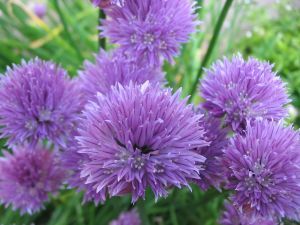Chives are the smallest member of the onion family and like onions; they are used in many recipes. Simply snip the tops of the chives with a pair of scissors. Chop the leaves up fine and add them to salads, or egg dishes. When chives flower, they form a pinkish purple pompom on top of the green stalk. The flowers are also edible and has a lively onion flavor. Break up the flower blossoms and add them to salads. Add whole flowers to a bottle of vinegar for a slightly different flavor.
Cutting chives is a way to encourage new growth. There are onion chives and garlic chives. If you forget which ones are which, you can examine the flowers they produce. The onion chives have purple flowers and garlic chives have white flowers.
Growing Chives Outdoors
Chives are easy to grow and will come up year after year. Before you begin planting, you must prepare the soil. Choose a location that receives plenty of sunshine. Chives grow best with full sun exposure.
Pull and remove all the weeds from the area. Chives do not like competition when they are just beginning to grow. Although once they are growing and established, you can plant them along the border of your flower garden.
Dig or till the soil when the spring comes and the soil warms. As you work up the soil, add some compost. The compost will add to the nutrient levels, helping your chives to grow well. The soil should have a PH level of 6 or 7.
Plant the chives in bunches. Plant about 5 bulbs per bunch and space each bunch about 4 inches apart. Water the chives and keep the area moist, but do not keep the ground soggy. If you don’t’ have starter plants, you can sow seeds in the soil. Thoroughly water the soil before you plant any chive seeds. Thinly scatter the seed over the soil and cover with a thin layer of compost. The compost must remain moist so the seeds will grow. It takes 7 to 10 days before the seeds germinate. Plant chives around your garden. They are a natural way to repel aphids.
Start the Chives indoors
If you want an early start on growing your chives you can start them indoors. You can plant the seeds in March or at least 6 weeks before planting them outdoors.
Choose a pot or pots that are at least 18 inches in diameter and a foot deep. Fill the pot three fourths full with well-draining potting soil. Water the soil until water comes out of the drainage holes. Scatter the chive seed over the top. Cover the seed with a thin layer of soil, and then mist the soil so it is moist.
Place a plastic cover over the top of the pot. This will help the soil retain moisture so the seeds can germinate. Place the pot in an area where the temperature remains around 60 and 70 degrees F. Check the pot for moisture daily and mist to keep the soil moist. If you see mold growing on top of the ground, remove the plastic for an hour. When the chives begin growing, you can continue to grow them under florescent lamps. Position the tops of the chive plants about two to four inches below the lights. To help harden them for growing in the garden, have an oscillating fan blowing. Do not turn the fan to a high speed or have it blowing directly on the chives. You just the air to move across the tops of the chives. Do this for at least two hours every day. This will reduce the shock on your plants when you set them outdoors, and it will give you shorter, sturdier chive plants.
When spring comes and the weather warms, you can transplant your chives into the soil. Keep the soil moist, by watering several times a week.
Preserving Chives
You can cut the chives as you need, but leave about a half inch of the stem above ground. When the chives flower, that is the time to cut them back.
If you don’t have a pot of chives growing on your indoor windowsill when the winter winds begin to blow, there are several ways to preserve them. Wash the chives and then place the chives into a plastic bag and stick them into the refrigerator. They will keep for 7 days. If you want to keep the chives longer, chop them up fine and place them in ice cube trays. Put the icecube trays into the freezer. Once the chive cubes are frozen, place them in a sealable plastic bag and keep them in the freezer. When your recipe requires chives, simply pull out a chive cube and toss it into your food.
There are several different ways you can dry your chives, but this will result in a loss of flavor. You can dry the chives in a dehydrator set on the lowest setting. If you don’t have a dehydrator, place the chopped chives in a single layer onto a cookie sheet. Set the cookie sheet into a 100 degree F. oven. It will take abour 4.5 hours to dry. You can also air dry the chopped chives. Place them on a cookie sheet and leave them to air dry for about 4 days. The length of time it takes to completely dry the chives depends on the amount of humidity in the air.






